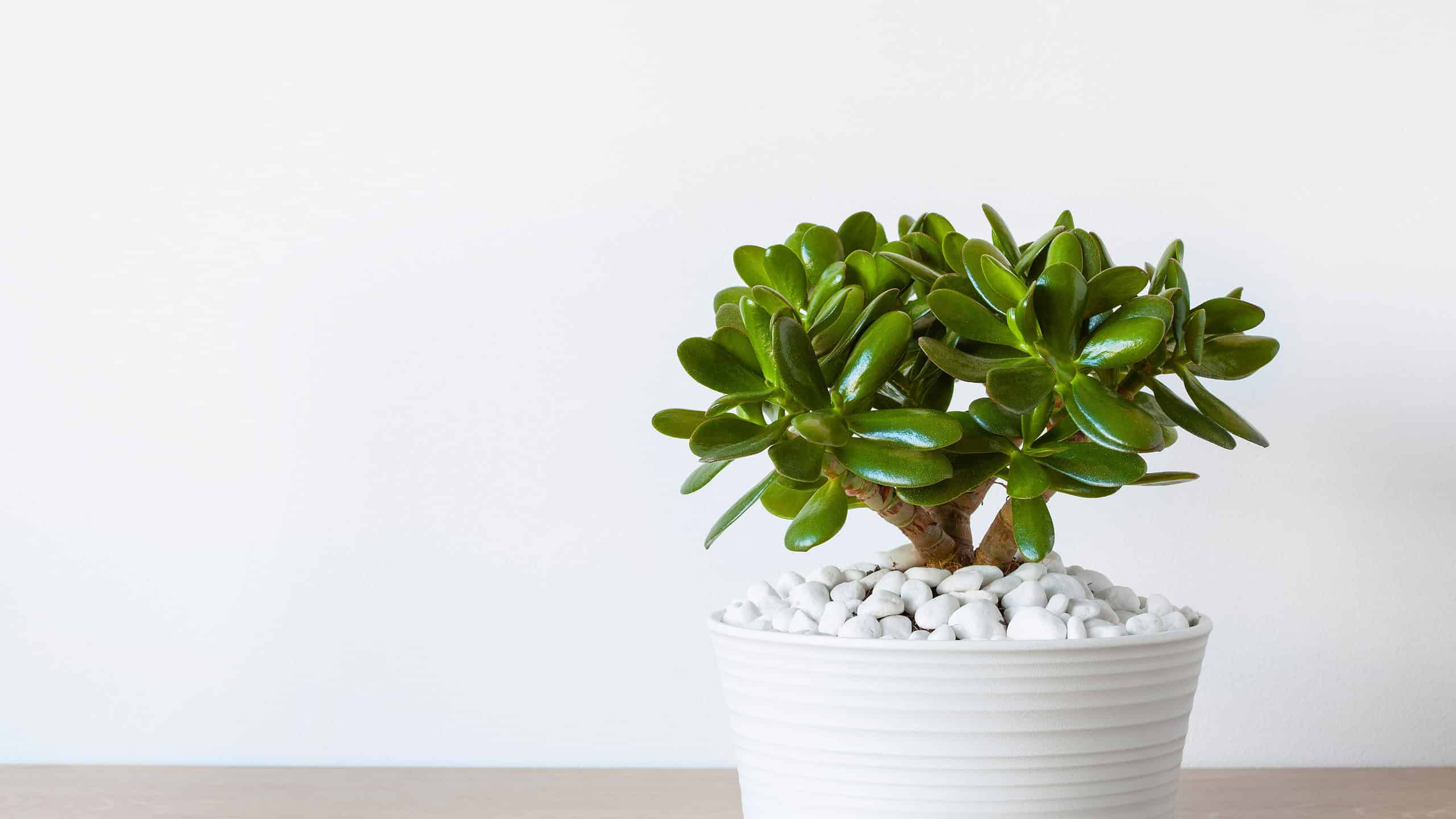Welcome to our comprehensive guide on growing jade plants indoors! Whether you’re a seasoned plant enthusiast or just starting out, this article will provide you with all the essential care tips and tricks for successfully cultivating these beautiful houseplants.
About Jade

You will know that your jade plant is in ideal light conditions if it has red-tinted leaves or flowers.
©HD Photographer Pro/Shutterstock.com
Jade, or Crassula ovata, is a popular houseplant that is easily recognizable with its thick, glossy leaves and thick, sturdy stems. The leaves are a deep, vibrant green and are oval-shaped with a pointy end. The leaves are often clustered together, giving it a lush, full appearance.
Jades typically grow up to three feet tall indoors and can even be trained to grow into tree-like shapes with multiple trunks. If given enough light, they are able to reach 6 feet tall. When in bloom, it produces small, star-shaped white or pink flowers. The flowers are beautiful and add a touch of color to any room.
One advantage of having a jade plant around is its longevity; when taken care of properly, it can survive for up to seven decades or even longer. This makes them perfect for handing down to future generations.
Light Requirements for Growing Jade Indoors

©TSViPhoto/Shutterstock.com
When growing jade indoors, provide at least six hours of bright, indirect sunlight per day.
For ideal lighting, the jade plant should be placed in a sunny spot such as a south or west-facing window. Six hours of bright, indirect light each day is the minimum. This will ensure the plant gets enough light to produce strong, healthy foliage. Symptoms of ideal light include bright green foliage and a healthy rate of growth. If your jade plant has a red blush to its leaves, it is very happy indeed.
If the plant is not receiving enough light, the leaves may become dull or yellow in color, and the growth rate may slow down. It can also get leggy stems that are weak and floppy. To prevent this from happening, make sure the jade plant is getting enough light by moving it to a spot with more direct sunlight.
On the other hand, too much light can be just as damaging as not enough. If the jade plant is exposed to too much direct sunlight, the leaves may become scorched or develop brown patches. To reduce the risk of this happening, keep the plant out of direct sunlight during the hottest parts of the day, especially during the summer.
Soil

A well-draining potting soil meant for succulents is ideal when growing jade indoors.
©iStock.com/naramit
When selecting a potting mixture for your jade plant, it is best to find a blend specifically tailored to succulent plants. This type of soil is lighter than regular potting soil, allowing for better draining and avoiding fungal growth due to too much moisture.
The perfect soil for jade plants should include sand, potting soil, and perlite or pumice. If need be, you can mix in perlite or pumice to any potting soil to ensure proper drainage. Clay or terracotta pots are also suggested since they absorb water from the soil. Lastly, jade plants thrive in a neutral to slightly acidic pH level – 7 to 5.5 on the pH scale – which most succulent potting mixes should provide.
Ideal Watering Schedule for Growing Jade Indoors
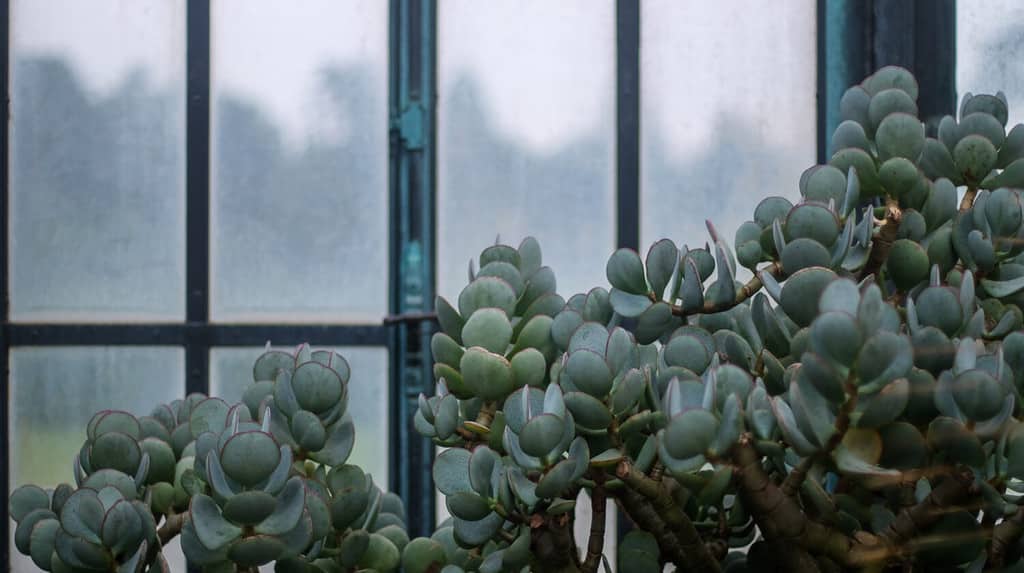
South or west-facing windows are perfect when growing jade indoors in the Northern Hemisphere.
©Bridget Moyer/Shutterstock.com
In order to keep a jade plant healthy, it is important to be aware of its seasonal water needs. During the spring and summer months, when it is actively growing, it should be watered deeply and then allowed to rest in a dry period. If too much water is given, root rot may occur since this type of succulent is used to growing in a desert-like climate with periods of drought. In the summer, the soil will dry out more frequently due to the higher temperatures and increased plant activity.
Keep the soil moist but not overly wet or saturated. A good rule of thumb is to let at least 50 percent of the soil dry out completely before watering a jade plant. When in doubt, wait. Overwatering is the number one cause of death when growing jade indoors, so if you aren’t sure, wait another week. Jades give a good clue when they are thirsty; their leaves get a little bit wrinkly and lose their shine, signaling thirst.
Temperature and Humidity
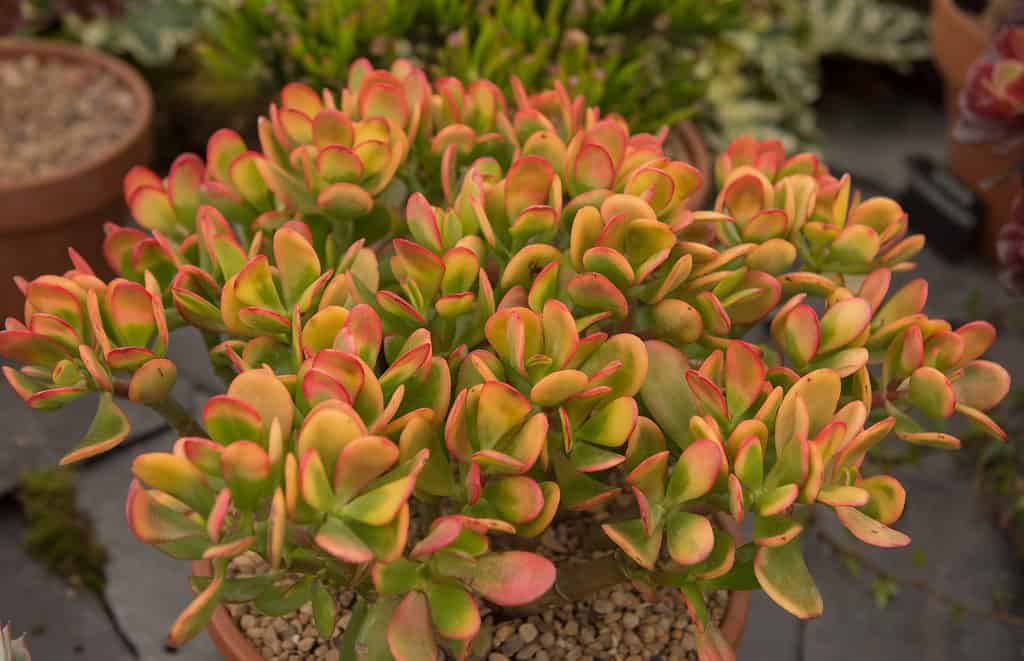
This eye-catching jade plant is very happy with temperatures above 65°F.
©Peter Turner Photography/Shutterstock.com
Maintaining the ideal temperature and humidity levels is essential for a healthy jade plant grown indoors. The optimal temperature range for a jade plant is between 65-75°F (18-24°C). The ideal humidity level for a jade plant is between 40-50%. They are used to living in an arid environment, so they are fine with air on the dry side.
It is important to provide good air circulation for a jade plant. However, when selecting a place for your jade plant, opt for an area that has consistent temperatures. Avoid putting it in a spot with frequently changing temperatures, like near an air conditioning or heat vent or in front of an open window or door, as this could cause too much stress for the plant as it works to adjust to the alternating temperatures.
How Often to Fertilize When Growing Jade Indoors
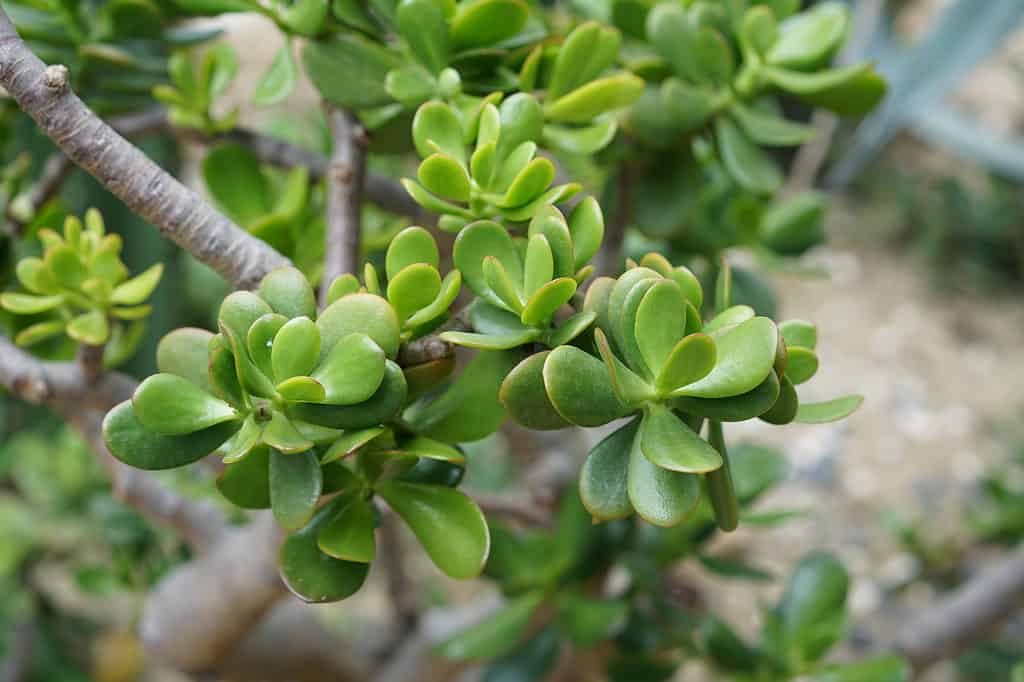
Feed a potted jade growing indoors once per month with a 10-20-10 fertilizer. Stop feeding in winter.
©iStock.com/Wirestock
Fertilizing a jade plant can be an important part of keeping it healthy and thriving. Generally, jade plants should be fertilized once a month during the growing season. When selecting a fertilizer, it is important to choose one that is high in phosphorus, such as a 10-20-10 fertilizer. This helps to promote flower production, strong stems, and a healthy root system.
When applying fertilizer, it is important to follow the manufacturer’s instructions for dilution and application. Additionally, avoid overfertilizing, as this can burn the roots of the plant and lead to nutrient deficiencies. Do not fertilize a jade plant during the winter months, as it prefers to sleep in the winter.
Another popular option is to use a liquid fertilizer, such as fish emulsion, diluted to 1/4 strength at every watering. If you follow this plan, you can use it every time you water the plant all year long. Many people have had good success with this method, as the weak fertilizer does not burn the plant or cause leggy growth.
Propagating
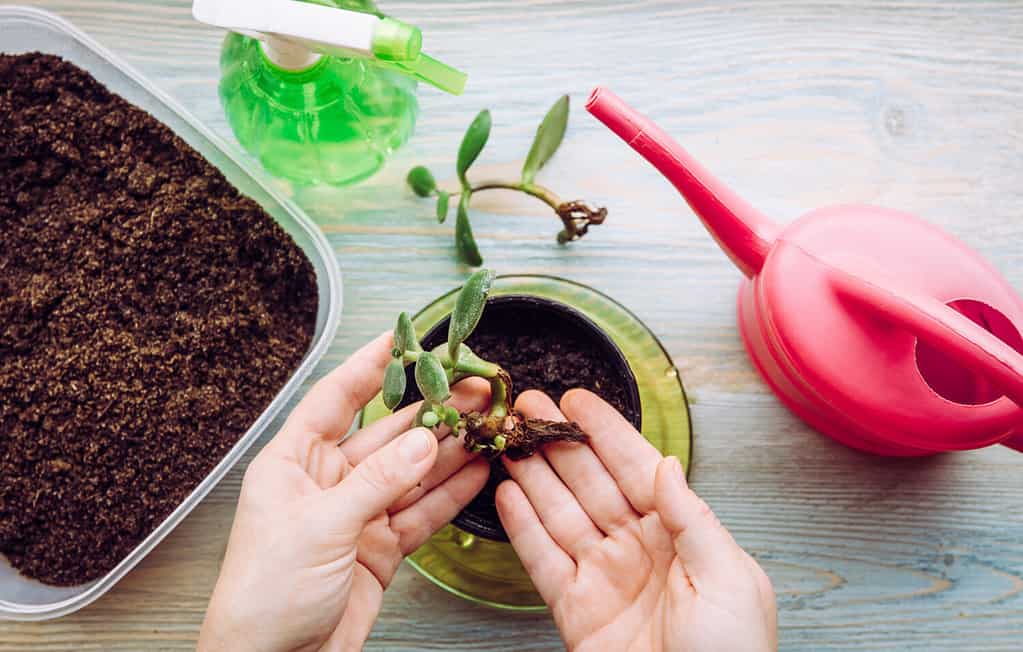
If you accidentally snap a stem or leaf off of your jade plant, never fear. You can propagate it!
©FotoHelin/Shutterstock.com
One of the most fun parts of growing jade indoors is the abundance of free plants. This plant is very easy to propagate! Your friends and neighbors had better get ready for some free plants. Because jade plants can be propagated from one single leaf, you are likely to have plenty to give away. To successfully propagate a jade, follow these steps:
How to Propagate a Jade Plant
- Carefully remove a healthy leaf from the stem of your jade plant. When you are moving the plant around to water it, you are likely to snap off a leaf or two. These can all be propagated.
- Let the leaf sit in a dry place for a few days. The end of the leaf (the end that used to be attached to a stem) will dry out and form a scab. After it has healed over, you are ready to propagate.
- This is an optional step, but for the very best success, dip the cut end of the leaf in a powdered rooting hormone.
- In a tiny pot, place half succulent potting soil and half perlite or vermiculite. Moisten the soil a few times to completely hydrate it.
- Place the leaf on top of moist soil and lightly press it down. You can orient the leaf sideways horizontally or with the cut end down onto the surface of the soil. As long as the cut-calloused end is touching the soil, it will grow roots. You do not need to bury it.
- Place the pot in an area that receives bright, indirect light.
- Keep the soil moist but not soggy until you see new roots begin to form. You are aiming for the level of dampness of a squeezed-out sponge here.
- Once roots are established, you will see a tiny baby plant start to form at the edge of the old leaf. Once that happens, you can start caring for the plant exactly like the parent plant.
- The above steps can be followed exactly the same for a leaf or a stem.
How to Repot a Jade Plant
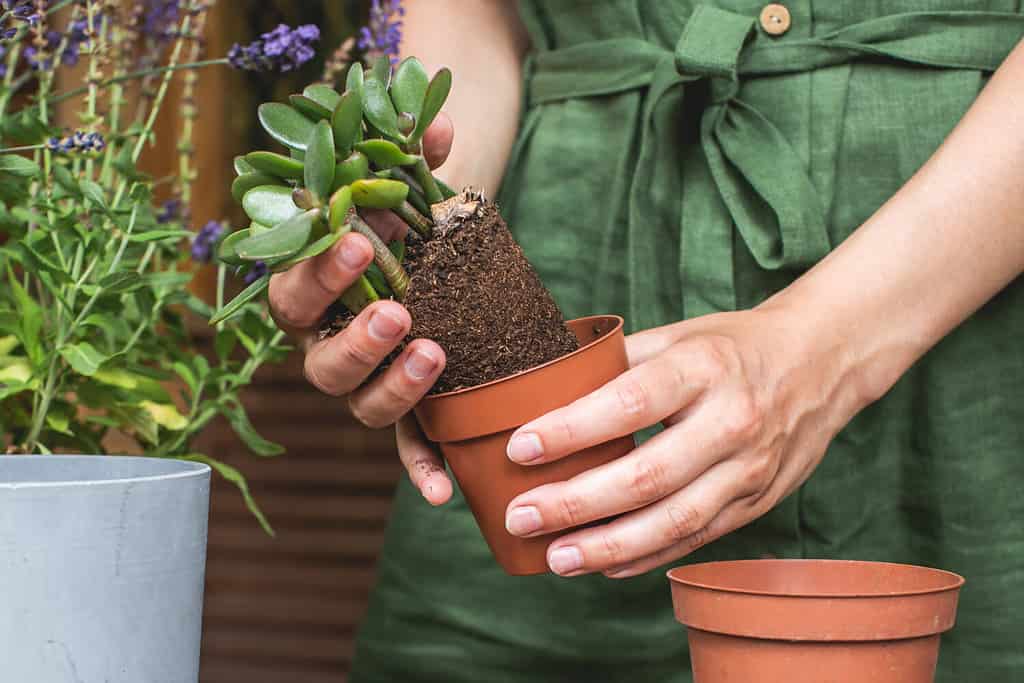
When growing jade indoors, select a pot that is only 2 inches bigger than the root ball to avoid root rot.
©Krichevtseva/Shutterstock.com
When selecting a container for your jade plant, bear in mind its current size. These plants have shallow roots and won’t benefit from a pot much bigger than the root ball. Actually, a planter that is too deep or big poses a danger of retaining too much moisture and potentially causing fungal issues in the root system.
If your jade is very rootbound or has roots growing out of the drainage holes, it is time for a new pot. Also, some large jades get top-heavy, so they may need to be potted in a heavier container.
- To start, pick a day when the jade’s soil is dry.
- Gently remove the jade from the pot. If any of the roots are rotten, cut them away and treat them with fungicide. If the roots are healthy, try as hards as you can not to disturb them. Jades is not a fan of transplanting, so be gentle.
- Select a pot that is two inches bigger than the root ball. Any bigger and you risk the chance of root rot.
- Place enough soil in the bottom of the pot so that the jade’s crown will be at the same level that it was in its old pot.
- Fill the pot with soil and firm it down.
- Water to remove air pockets and hydrate the soil.
Pests To Look For When Growing Jade Indoors

Inspect your plant weekly when growing jade indoors. Then, you can catch pest problems early!
©svf74/Shutterstock.com
- Spider mites: These tiny pests are barely visible to the naked eye and typically appear as small moving dots. They can be eliminated by treating the plant with rubbing alcohol or insecticidal soap.
- Mealybugs: These soft-bodied insects are white and covered in a waxy substance. To remove them, wipe the leaves with a cotton swab dipped in rubbing alcohol.
- Aphids: These small insects are usually green and may appear in large clusters. To eliminate them, spray the plant with insecticidal soap or use insecticide granules in the soil.
- Scale: These small, brown insects can be hard to spot as they blend in with the leaves. Control them by treating the plant with horticultural oil.
- Whiteflies: These tiny, white, flying insects can be eliminated by spraying the plant with insecticidal soap.
- Fungus gnats: These small, dark flying insects are attracted to moist soil. To control them, let the soil dry out between waterings or use an insecticide.
Diseases
- Symptoms: yellowing and wilting of leaves, brown or black spots on the leaves, mushy and soft stems
- Treatment: repot the plant and prune the affected roots and leaves. Use a fungicide
Mildew
- Symptoms: white powdery substance on the leaves and stems
- Treatment: reduce humidity, increase air circulation, and use a fungicide
Why Are My Jade’s Leaves Shriveled?
Most commonly, shriveled leaves are the result of a lack of water. Make sure to keep your plant’s soil moist but not soggy, and water it regularly. If the soil is too dry, jade’s leaves can start to look wilted and wrinkled.
Other causes for shriveled leaves could be pests or diseases. Check if any bugs are present in your plant, like aphids, scale, or white flies.
Why Is My Jade Plant Drooping?

These wilted, crispy jade leaves are an indication of underwatering or a pest infestation.
©atewi/Shutterstock.com
Drooping leaves can be caused by a few different things, including under-watering or over-watering. Make sure to water your plant when the soil is dry and only as much as it needs. If you’ve been overwatering, let the soil dry out more between waterings.
Insects may also cause drooping leaves if they are feeding on the plant’s sap. Check for any pests like aphids, mealybugs, or spider mites. If you find any, use an insecticide to get rid of them.
Less commonly, it could be a temperature shift caused the plant to droop, or the jade is not getting enough food and cannot grow strong, stiff stems.
Why is My Jade Losing Leaves?
The most common reason for leaf drop when growing a jade indoors is insufficient sunlight. Jade plants need bright, indirect sunlight to remain healthy. If your jade is not receiving enough light, it will drop its leaves in an effort to conserve energy. Move it to a sunnier spot, and you should start seeing new growth soon.
Another cause for leaf loss could be temperature. If you have your jade in a very hot location, it will instinctively drop its oldest leaves. If you notice that most of the leaves that are falling are old-growth, move the plant to a location that is between 65-75°F.
Why is My Jade Turning Yellow?
A couple of yellow leaves occasionally is normal. More than a couple is a cause for concern. All-over yellowing of leaves is usually from overwatering and rotten roots. The roots are so mushy and decayed that the plant can no longer take up nutrients from the soil, causing yellow leaves.
Thank you for reading! Have some feedback for us? Contact the AZ Animals editorial team.

